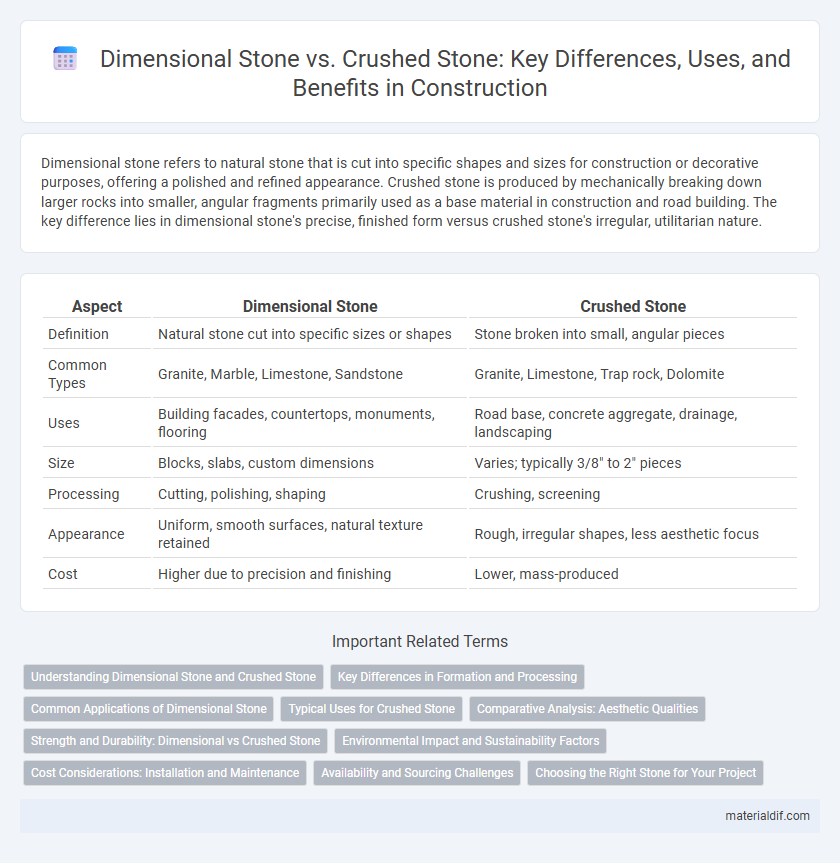Dimensional stone refers to natural stone that is cut into specific shapes and sizes for construction or decorative purposes, offering a polished and refined appearance. Crushed stone is produced by mechanically breaking down larger rocks into smaller, angular fragments primarily used as a base material in construction and road building. The key difference lies in dimensional stone's precise, finished form versus crushed stone's irregular, utilitarian nature.
Table of Comparison
| Aspect | Dimensional Stone | Crushed Stone |
|---|---|---|
| Definition | Natural stone cut into specific sizes or shapes | Stone broken into small, angular pieces |
| Common Types | Granite, Marble, Limestone, Sandstone | Granite, Limestone, Trap rock, Dolomite |
| Uses | Building facades, countertops, monuments, flooring | Road base, concrete aggregate, drainage, landscaping |
| Size | Blocks, slabs, custom dimensions | Varies; typically 3/8" to 2" pieces |
| Processing | Cutting, polishing, shaping | Crushing, screening |
| Appearance | Uniform, smooth surfaces, natural texture retained | Rough, irregular shapes, less aesthetic focus |
| Cost | Higher due to precision and finishing | Lower, mass-produced |
Understanding Dimensional Stone and Crushed Stone
Dimensional stone refers to natural rock that is quarried and cut into specific sizes and shapes for use in construction, architecture, and design, such as granite blocks, marble slabs, and limestone panels. Crushed stone is produced by mechanically breaking down larger rocks into smaller, angular pieces commonly utilized as aggregate in concrete, road base, and landscaping. Understanding the distinction highlights dimensional stone's aesthetic and structural precision versus crushed stone's functional, versatile application in infrastructure projects.
Key Differences in Formation and Processing
Dimensional stone is quarried in large blocks and precisely cut into specific shapes and sizes, highlighting its natural formation in solid, contiguous deposits like granite, marble, or limestone. Crushed stone results from blasting and crushing larger rocks mined from quarries, creating angular fragments used primarily for construction aggregates and road base materials. The key difference lies in dimensional stone's emphasis on aesthetic value and structural integrity versus crushed stone's functionality in foundational and infrastructural applications.
Common Applications of Dimensional Stone
Dimensional stone, such as granite, marble, and limestone, is commonly used in architectural projects for building facades, flooring, and countertops due to its precise cutting and aesthetic appeal. Unlike crushed stone, which serves mainly as a base material in construction and road-building, dimensional stone provides structural and decorative qualities for monuments, sculptures, and interior design elements. Its ability to be shaped into specific sizes and polished surfaces makes it ideal for high-end residential and commercial applications.
Typical Uses for Crushed Stone
Crushed stone is commonly used in construction projects such as road base, concrete aggregate, and drainage systems due to its angular shape and durability. It serves as an essential material for stabilizing surfaces in driveways, walkways, and foundations. Its versatility makes it ideal for landscaping applications where drainage and erosion control are critical.
Comparative Analysis: Aesthetic Qualities
Dimensional stone offers precise cuts and uniform shapes, enhancing architectural aesthetics with clean lines and consistent textures ideal for facades and decorative elements. Crushed stone provides a more rugged, irregular appearance, often used for foundational support or landscaping where natural, rustic looks are preferred. The choice between dimensional and crushed stone significantly impacts visual appeal, with dimensional stone favored for polished, refined designs and crushed stone for organic, textured environments.
Strength and Durability: Dimensional vs Crushed Stone
Dimensional stone exhibits greater strength and durability compared to crushed stone due to its large, quarried blocks that retain natural structural integrity. Its uniform thickness and controlled cutting processes enhance resistance to weathering and mechanical stress. Crushed stone, fragmented from larger rocks, offers less durability and strength but provides superior flexibility for construction applications requiring drainage and compaction.
Environmental Impact and Sustainability Factors
Dimensional stone, such as granite or marble slabs, typically involves less energy consumption during extraction and processing compared to crushed stone, leading to a lower carbon footprint. Crushed stone production requires extensive crushing and screening, resulting in higher energy use and increased particulate emissions. Sustainable sourcing of dimensional stone also allows for more efficient waste utilization and longer lifecycle in construction, reducing overall environmental impact.
Cost Considerations: Installation and Maintenance
Dimensional stone typically incurs higher installation costs due to the precision cutting, specialized labor, and customized fitting required, whereas crushed stone benefits from simpler, quicker installation processes and lower labor expenses. Maintenance costs for dimensional stone can be elevated because of its susceptibility to chipping and the need for periodic sealing to preserve appearance and durability, while crushed stone generally demands minimal upkeep, mainly consisting of occasional replenishment and leveling. Budget planning for landscaping or construction projects should carefully weigh these factors to optimize long-term cost efficiency and material performance.
Availability and Sourcing Challenges
Dimensional stone, such as granite or marble slabs, is quarried in large blocks that require specialized extraction and transportation methods, making availability limited to specific geographic regions with suitable deposits. Crushed stone, typically derived from diverse rock types like limestone or basalt, is more widely available due to abundant natural resources and simpler extraction processes. Sourcing challenges for dimensional stone include high costs and logistical complexities, while crushed stone benefits from widespread quarry locations and lower production barriers.
Choosing the Right Stone for Your Project
Dimensional stone offers precise shapes and polished surfaces ideal for architectural and decorative projects requiring uniformity and visual appeal. Crushed stone provides varied sizes and angular fragments suited for foundational support, drainage, and road construction due to its compactability and strength. Selecting the right stone depends on project specifications, with dimensional stone excelling in aesthetic applications while crushed stone ensures structural integrity.
Dimensional Stone vs Crushed Stone Infographic

 materialdif.com
materialdif.com